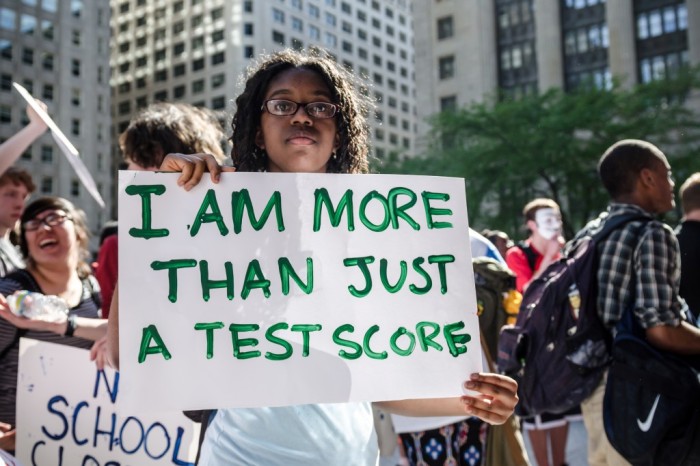
Brace yourselves!
America’s NAEP test scores in 2019 stayed pretty much the same as they were in 2018!
And the media typically set its collective hair on fire trying to interpret the data.
Sometimes called the Nations Report Card, the National Assessment of Educational Progress (NAEP) test is given to a random sampling of elementary, middle and high school students in member countries to compare the education systems of nations.
And this year there was one particular area where US kids did worse than usual!
Our scores went down in 8th grade reading!
To be honest, scores usually go up or down by about one or two points every year averaging out to about the same range.
But this year! Gulp! They went down four points!
FOUR POINTS!
What does that mean?
Absolutely nothing.
They’re standardized test scores. They’re terrible assessments of student learning.
You might as well compare the relative body temperatures of randomly selected students and wonder why we aren’t bridging the body warmth gap with the somber hummingbird! I mean it has an average temperature of 114 F! And the best we can do is a measly 98.6 F! Why won’t enough kids get a fever for America!?
If test scores have any meaning at all – it’s parental wealth. Rich kids tend to score higher than poor kids. That’s partially because of the inequality of resources each receive, but also because of racial, cultural and economic bias embedded in the questions.
So the NAEP shows us what any study of parental income would show. America has a lot of poor kids and underfunded schools.
Thanks, NAEP! There’s no way we could ever have figured that out without you!
But having this information come to us via test scores allows us to deflect from the real problem and instead continually blame the victim.
I can’t imagine!
Typically politicians used the results to push their pet policies.
Education Secretary Betsy DeVos used the scores to wash her hands of the entire public education system. I know – isn’t her job to safeguard public schools? It’s like a zoo keeper complaining that the penguins aren’t bringing in enough visitors and then refusing to feed them.
DeVos proposed we improve test scores by cutting $4.8 billion from public schools in 2020 and instead pumping $5 billion to a tax credit school voucher scheme that props up private schools.
I know that sounds dumb, but before you judge her, realize she also proposed cutting federal funding for afterschool programs, teacher professional development, student support and enrichment programs.
So there.
She says that the NAEP results mean that 2/3 of American students read below grade level. However, Greene points out that she is conflating two different things – grade level proficiency and NAEP proficiency.
Here’s what the NAEP wrote:
“The NAEP Proficient achievement level does not represent grade-level proficiency, but rather competency over challenging subject matter. NAEP Achievement levels are to be used on a trial basis and should be interpreted and used with caution.”
Which kind of begs the question of why we need these scores in the first place.
There is much clearer data out there.
A study by the Center on Budget and Policy Priorities concluded that 29 states spent less per student in 2015 than they had before the Great Recession.
And the federal government has done little to help. Since 2011, spending on major K-12 programs – including Title I grants for underprivileged students and special education – has been basically flat.
According to the Economic Policy Institute in Washington, today’s public schools employ at least 250,000 fewer people than they did before the recession of 2008–09. Meanwhile enrollment has increased by at least 800,000 students.
So to ensure our students had the same quality of service children received only a decade ago, we’d need to hire almost 400,000 more teachers!
That’s how you cut class size down from the 20, 30, even 40 students packed into a room that you can routinely find in some districts today.
If we looked at realities like these instead of test scores – which at best provide us data at several removes – we might actually be motivated to reach solutions.
For instance, the U.S. is one of the only countries in the world – if not probably the ONLY country – that funds schools based largely on local taxes. Other developed nations either equalize funding or provide extra money for kids in need. In the Netherlands, for example, national funding is provided to all schools based on the number of pupils enrolled. But for every guilder allocated to a middle-class Dutch child, 1.25 guilders are allocated for a lower-class child and 1.9 guilders for a minority child – exactly the opposite of the situation in the U.S.
If we want to compare the US to other countries, this is a perfect place to start.
But a focus on test scores obscures the differences.
Virtually all of the top scoring countries taking these exams have much less child poverty than the U.S. If they had the same percentage of poor students that we do, their scores would be lower than ours. Likewise, if we had the same percentage of poor students that they do, our scores would go through the roof! We would have the best scores in the world!
These scores just mirror back to us our child poverty rate – that more than 1/3 of our students live below the poverty line and more than half of public school students qualify for free or reduced lunches.
But this myopic focus on standardized tests also blinds us to the ways our system is superior to that of many other countries.
We do something that many international systems do not. We educate everyone! Foreign systems often weed children out by high school. They don’t let every child get 13 years of grade school (counting kindergarten). They only school their highest achievers.
So when we compare ourselves to these countries, we’re comparing ALL of our students to only SOME of theirs – their best academic pupils, to be exact. Yet we still hold our own given these handicaps!
This suggests that the majority of problems with our public schools are monetary. Pure and simple.
At least House Democrats passed a Labor-HHS-Education funding bill to increase public school funding by $3.5 billion. Even if it were somehow passed by the Republican controlled Senate, that’s a drop in the bucket after decades of neglect – but it’s something!
It’s certainly better than DeVos who claims that funding somehow doesn’t matter for public schools – only for her pet charter and voucher schools.
A 2018 review by Northwestern University found that in 12 out of 13 studies increased spending had a positive effect on student outcomes. And that result has been verified by studies since then in California, Texas, Wisconsin and other states.
Money spent on students – not more testing.
So why the drop in this year’s 8th grade reading scores?
Who knows? It could be a spike in the rate or effect of child poverty in the middle school years.
It could be the impact of decades of high stakes testing on middle school curriculum – narrowing what is taught and muscling out authentic instruction.
Frankly it doesn’t matter because the data is suspect.
And until we, as a society, finally realize that and focus on things that actually matter, we will continue to fail the only test that matters – how well we provide for our children.
Like this post? I’ve written a book, “Gadfly on the Wall: A Public School Teacher Speaks Out on Racism and Reform,” now available from Garn Press. Ten percent of the proceeds go to the Badass Teachers Association. Check it out!









